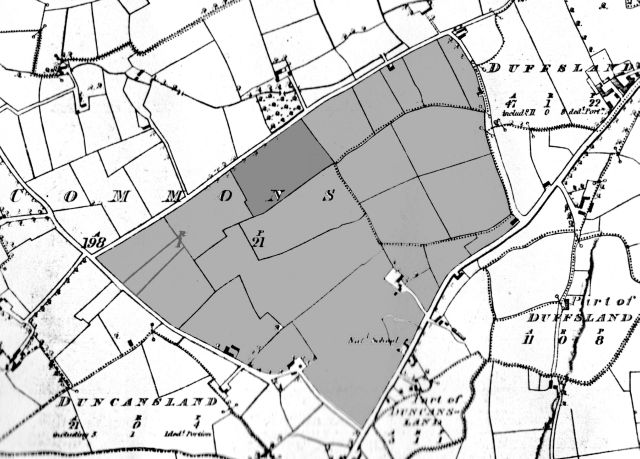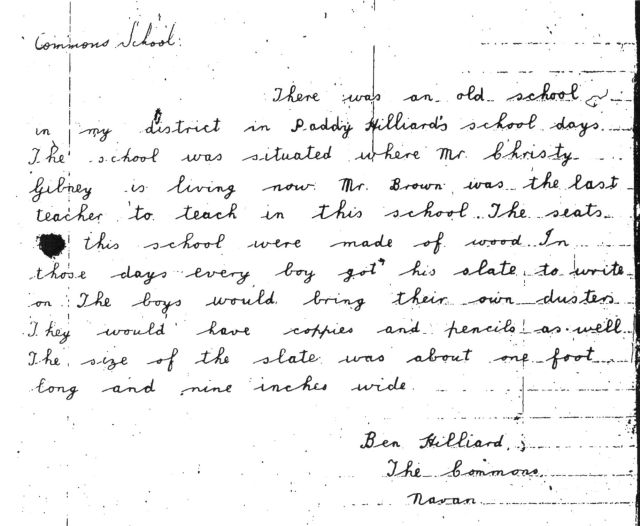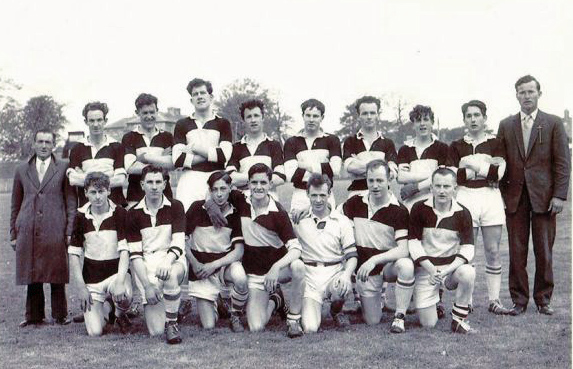Commons of Navan

Navan Commons
From the 1837 O.S. Map
Navan Commons John O'Donovan. Ordnance Survey Field Name Book 1835-1836
The Navan Down Survey
The Navan Commons Down Survey Map
Bounded on the north by the townlands of Robinrath, Mullaghboy and Knockumber.
Bounded on the east by by the townlands of Duffstown Nos. 1 and 3., Old Balreask and Duncansland.
Bounded on the south by Ardbraccan parish and Parkboy townland.
It is 1/2 mile from Navan town.
It is well intersected by bye roads, and the roads from Navan to Athboy and Trim pass through it.
*******
The Commons of Navan
by C. C. Ellison
The Portreeve was usually non resident and acted through his Deputy, the Rev. Francis Dansey Hamilton, who also held the sinecure Vicarage of Athlumney.
Hamilton had become Portreeve before he died in 1832, and no doubt having regard to the cessation of the revenue from tolls had disposed of the Corporation land to his friends.
This land granted by Charter, had originally amounted to over 1200 acres. It was called "the Commons of Navan," and extended out some two miles on the Trim side of the town.
"The Commons of Navan," says Thompson, "are the worst regulated of any grounds of this description in the country, and I am sorry to say are a receptacle for vagabonds from all quarters. There is little or no restrictions on any person who likes to build a cabin and enclose a garden on these Commons. The consequence is that more robberies have been committed by persons living in that quarter, than in any other district in the country, robbers from every direction finding there a secure refuge and place of concealment."
The Corporation appointed a "Ranger of the Commons" in the mid 18th century to "care for the firs, grass, and sod of the sd. commons", and to report " all such persons as shall attempt to cut the sd. firs or commit any other trespass on the sd. ground."
He appears, however, to have been powerless to prevent enclosing and building. A survey a map were ordered to be made in 1760, but the land and its squatters continued to be a problem. The Corporation met specially in 1767 "to consider the most effectual means of of making the commons of this town useful, which is now only a harbour for vagabonds"
The adjoining big landowners continued to enclose parts of it, and in 1776, the Corporation granted 40 acres to the Rector, Dr. Beaufort, for a Glebe, and another 30 to the Rev. Richard Barry for a School. Neither of these grants apparently ever took effect.
In 1797 four acres were granted to an association of gentlemen called "the Navan Bank." This was significantly termed "Lot No.1" Between 1820 and 1835 the remaining 118 acres were parcelled out to "persons in favour with the Corporation."
So vanished an asset, which would have been of great value to the town today, as the Commons on the Hill of Lloyd still is to the citizens of Kells.
The 1835 Commissioners mention the lease in 1713 to John Tench, the Town Clerk, of Moninbeggals Hurling Park (93 acres), Calf Park alias Bullock's Park, with the old penfold and the little bog adjoining (8 acres), to be held for ever at a rent of £1-2-0 a year.
The Hurling Park belonged to the Abbey before the Dissolution. The Statutes of Kilkenny (1366) banned the game for the English, and 20 years later an Armagh Synod prohibited "the faithful of the Province from playing that reprehensible game," because it " caused 2 mortal sins and beatings and often homicides" (Reg. Primate John Swayne, ed. Chart. p. 12) In the 18th century the game was played on a big scale with sides of up to 100 players. Sometimes the prize in view was a bride for the leader of the winning side.
Source: C. Maxwell, Country and Town in Ireland under the Georges, p. 156
*******
The Commissioners state also that the town had possessed three Fair Greens of considerable extent, which had been built upon with the permission of the Portreeve.
They cite the grant in 1813 to George Brady of a building plot for the term of 999 years, at a rent of £1-10-0 a year, as an example. Brady built two houses, but was never asked for any ground rent. A considerable portion of the Fair Greens remained in the possession of Miss Hamilton, the Portreeve's sister, after his death in 1832.
At an earlier period, in 1773, Robert Hamilton and his heirs had been granted a rent of £10 a year for the use of the Corn Market Place, and a passage 14 feet wide leading from the same to the High Park.
*******
Source for quote below:
Peter Connell, Changing Forces shaping a Nineteenth Century Irish Town A Case Study of Navan, Maynooth 1978
"Generally in County Meath estates were well regulated and sub division was strictly curtailed. What badly managed land existed was thus immediately attractive to those labourers seeking a place to live and a piece of ground on which to grow potatoes. The Commons of Navan, according to contemporary accounts, fell into this category. Granted by charter, the Commons of Navan origanally amounted to over 1,200 acres on the Trim side of the town. Enclosure and squatting had been a problem even in the 18th century. For example the Corporation met in 1767 ' to consider the most effectual means of making the commons of this town, which is now only a harbour for vagabonds'.
Thompson commented in 1802 that 'the Commons of Navan are the worst regulated of any grounds of this description in the country and I am sorry to say are a recaptacle for vagabonds from all quarters. There is little restriction on any person who likes to build a cabin and enclose a garden on this commons.' Whatever about the moral qualities of those inhabiting the area, it does seem that many who had been made landless in the area gravitated towards the Commons.
By 1821 its actual area had been whittled down to 120 acres which were settled by 81 families, or 426 persons. This represents an asthonishing density of 2,130 per square mile in an essentially rural economy. Agricultural labourers and those engaged in domestic industry accounted for 80.7% of the workforce in 1821, while linen weaving and flax spinning alone accounted for 48.2% of the total.
*******
If you look carefully at the map above you will see the location of a small school that once existed here.
Below is an extract from the Schools' Manuscript Collection of 1937.

Schools' Manuscript Collection from St. Columba's Abbey School Navan - Br. Abban O'Donohue.

(above) Commons Rd. Football Team (photo courtesy Carmel McGuinness)
Back row (l-r) Paddy Boyle, Frank Rafferty (RIP), John Moran, George Murphy, Joe Reilly, Unknown, - Woods, Tony Faulkner (RIP), Larry Boyle, Eamonn Kane
Front row (l-r) Oliver Mitchell?, Leo Carolan, Toddy Boyle, Benny Kane, Benny Kilbride, George Murphy and Dinny Gibney ("The Gamsher")